A pressure-calibration method of wavelength modulation spectroscopy in sealed microbial growth environment*
Kun-Yang Wang(王坤陽), Jie Shao(邵杰), Li-Gang Shao(邵李剛), Jia-Jin Chen(陳家金),Gui-Shi Wang(王貴師), Kun Liu(劉琨), and Xiao-Ming Gao(高曉明),2
1Anhui Institute of Optics and Fine Mechanics,Chinese Academy of Science,Hefei 230031,China
2University of Science and Technology of China,Hefei 230031,China
3College of Physics and Electronic Information Engineering,Zhejiang Normal University,Zhejiang 321004,China
Keywords: second harmonic amplitude,pressure-calibration,microbial growth,sealed environment,CO2
1. Introduction
Monitoring microbial growth plays an important role in a wide range of fields spanning from medical diagnosis to food microbiology.[1–4]Microbial growth occurs in a sealedenvironment bottle(or medium)with a limited supply of nutrients,it goes through by four distinct phases:[5]the lag phase,the exponential growth phase (or log growth phase), the stationary phase, and the death phase (or decline phase). The lag phase is the initial period of slow growth, during which time microorganisms adapt to the medium and synthesize critical proteins. The lag phase is followed by the exponential growth phase. With the number of cells doubling every unit of time, rapid microbial growth presents exponential growth.During the stationary phase, the growth rate of microorganisms is nearly equal to the death rate of microorganisms because nutrients are depleted in the medium,and the conditions become unfavorable for survival. During the death phase,the growth rate of microorganisms decreases and finally reaches zero.[2,6]The modified Gompertz model is widely used to describe these phases.[5]Microorganisms using respiration as a metabolic pathway release carbon dioxide (CO2). Thus CO2as a reliable indirect indicator,the amount of CO2produced in this period accurately reflects the above microbial growth process. BacT/ALERT blood culture bottles based on reflectance spectrometry have been applied to measure the color variation of CO2sensitive receptors in microbial growth.[7]However,such detection is susceptible to contamination and each data point needs to take half an hour.[8]
Wavelength modulation spectroscopy (WMS) with second harmonic (2f-WMS) as a real time, non-invasive, and high-accuracy detection technology is especially suited for gas detection.[9–12]Though detecting the CO2metabolized by microorganisms, this technology can quantify microbial growth. Thus in recent years, WMS has been used to study metabolic CO2produced above culture medium, for example,our group used WMS to swiftly assess CO2produced by microbial growth with a Hz resolution.[13]This implies that WMS can rapidly and accurately obtain the information of microbial growth. Brueckner et al. used to determine CO2changes in headspaces of the bottles that induced by metabolically active microorganisms.[14]However, it is worth noting that the above traditional WMS is affected by pressure broadening effect when detecting metabolic CO2in sealed microbial growth environment.Because,in traditional WMS,the 2f amplitude is often employed for gas concentration retrieval under constant pressure condition,[15–17]but for microbial growth,produced CO2will continue to increase and cause the pressure continuously increase in the sealed-environment bottle.It affects the line shape of the 2f signal and leads to the reduction of the 2f amplitude.[18]This effect makes 2f-WMS unable to accurately detect metabolic CO2in sealed microbial growth environment, thus the pressure calibration should be performed in this detection.
In this paper, we propose a new pressure-calibration method to calibrate the reduction of the 2 f amplitude which is caused by pressure broadening effect in sealed microbial growth environment. The new method differs from traditional 2 f amplitude in a significant way: it combines with linewidth compensation and modulation depth compensation,and makes the 2f amplitude accurately retrieve metabolic CO2without being affected by pressure broadening effect. Furthermore,in order to verify the method,a simulation experiment was developed,in which the increasing CO2concentration leaded to the increasing pressure. Comparing with the relation between the traditional 2f amplitude and CO2concentration, there was a monotonous relation between the calibrated 2 f amplitude and CO2concentration, particularly, a linear relation was developed when CO2concentration was replaced with the CO2particle number. In terms of microbial measurement,the growth of Escherichia coli was measured, and the culture bottle was sealed during the microbial growth process. The traditional 2 f amplitude and calibrated 2 f amplitude were used to detect CO2in the microbial growth. The experimental result showed that comparing to the traditional 2 f amplitude,the calibrated 2 f amplitude can accurately retrieve microbial growth in sealed environment.
2. Methods and system details
2.1. Theory
According to the article mentioned above,as microorganisms growing and metabolizing CO2, the pressure P and the particle number N in the sealed culture bottle environment satisfy the state equation of gas

where NA[mol?1]is the Avogadro constant,V is the gas volume,n is the gas amount of substance,R[J/(mol·K)]is the gas constant,and T [K]is the thermodynamic temperature.The air particle number in the sealed-environment culture bottle is N0,the initial pressure P0is normal pressure(1 atm); at a certain time t(t >0),the CO2particle number produced by microbial growth is Nt, and the pressure in the sealed-environment culture bottle is Pt[atm]. According to the above equation, the pressure Ptat time t can be obtained as

Here Nt+N0is the total particle number in the sealedenvironment culture bottle at time t. Thus, the CO2concentration X [%]at time t can be obtained as

From Eqs. (2) and (3), the relation between pressure Ptand concentration X in the sealed-environment culture bottle can be given by

It can be seen from Fig.1 that the relation between Ptand X in the sealed-environment culture bottle is a nonlinear curve,and the increasing CO2concentration causes the increasing pressure.
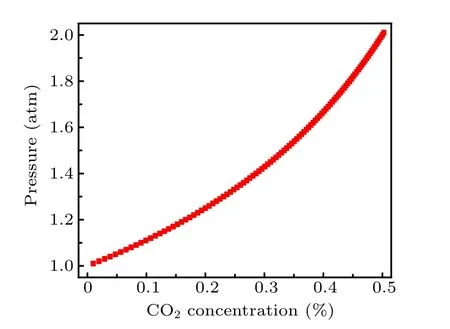
Fig. 1. The relation between pressure Pt and concentration X in the sealed-environment culture bottle.
The fundamental principle of 2 f-WMS is the Beer–Lambert law, which describes the relation between the incident and the transmitted radiation when the laser beam passes through a uniform gas medium. According to the Beer–Lambert law and the weak gas absorption, the absorption coefficient αvis defined by
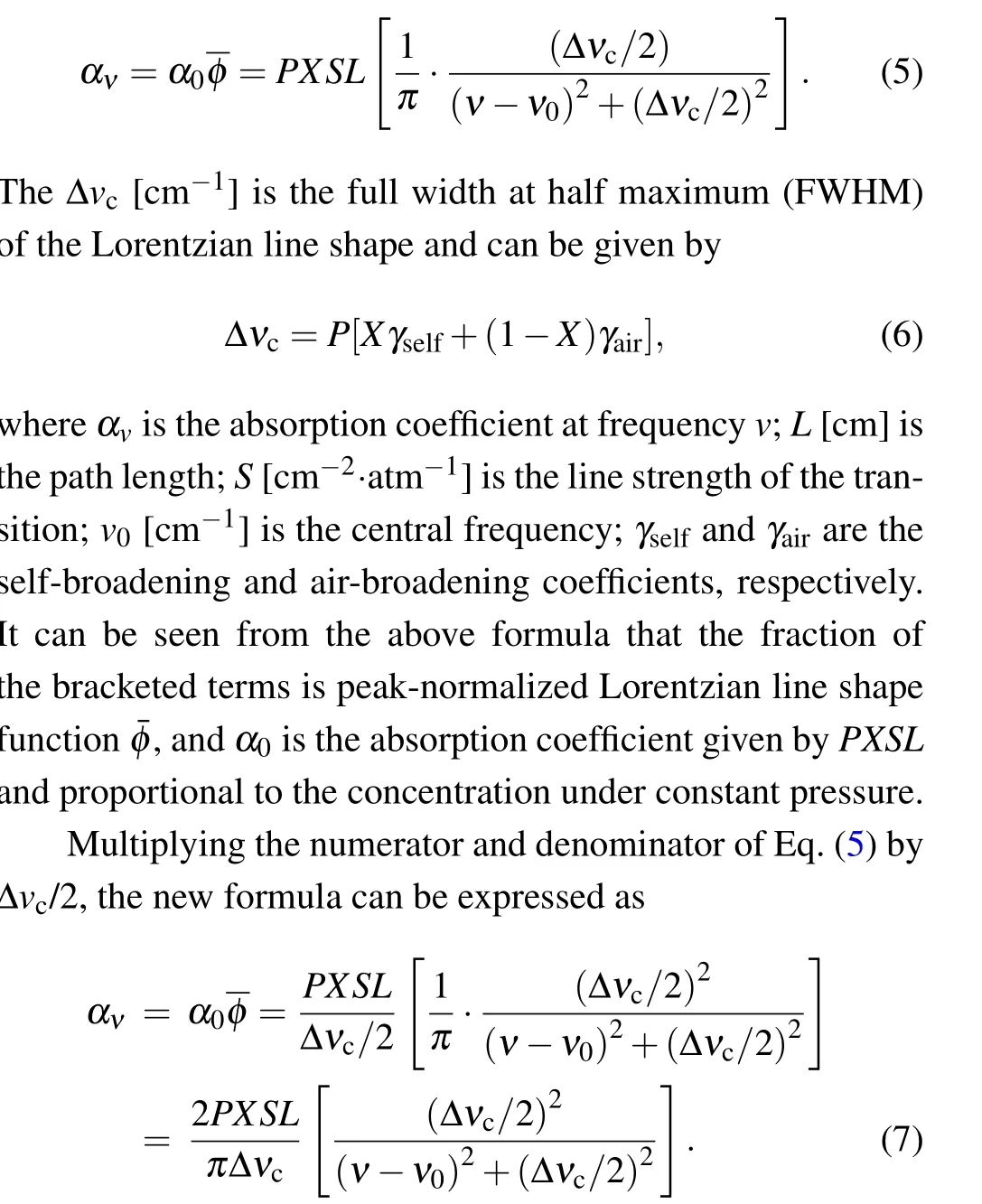
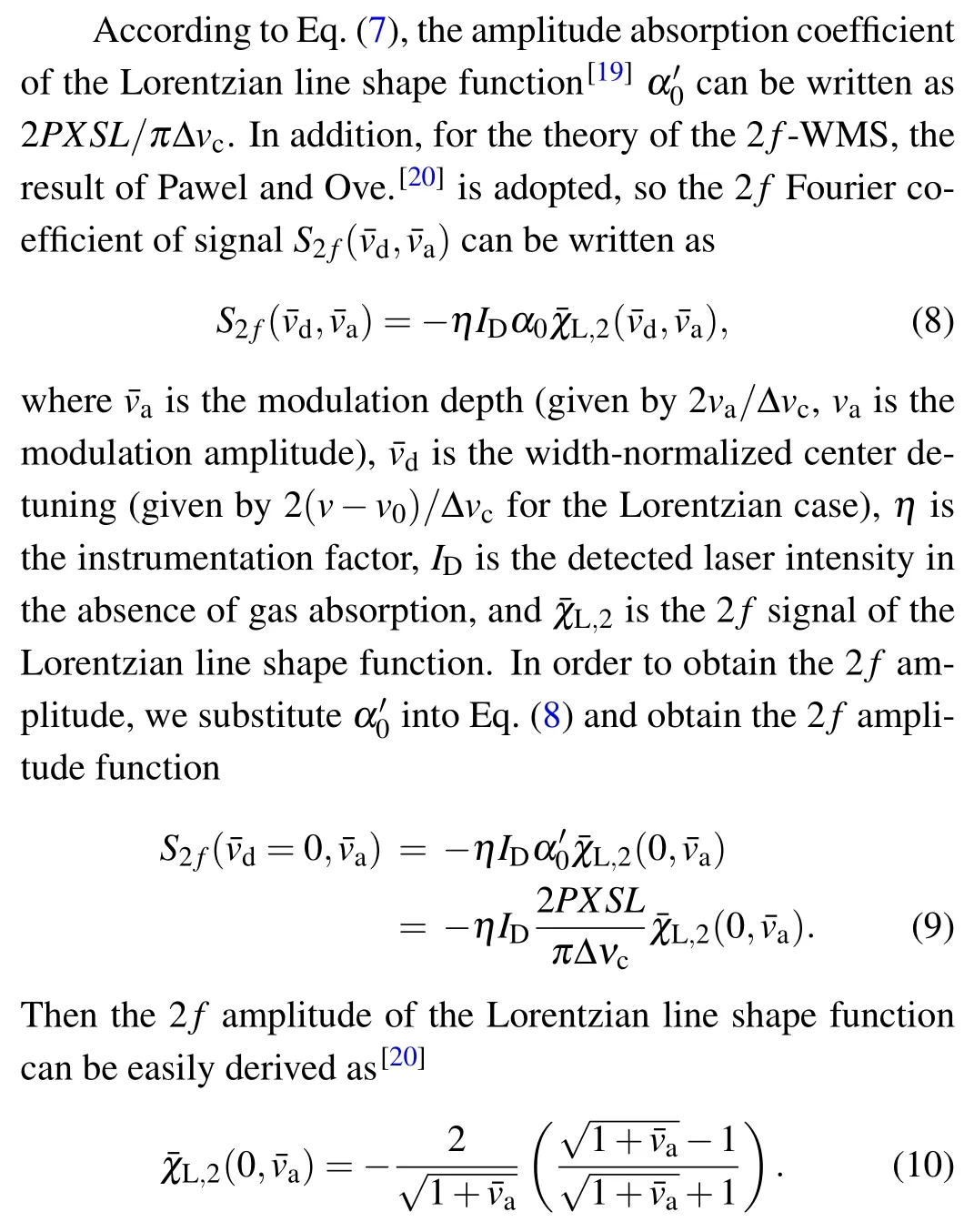
Combining Eqs.(6)and(9),we can find the principle of pressure broadening effect:Increasing pressure P can broaden linewidth Δvcand affect the modulation depth ˉva, so that reduce the 2 f amplitude. Thus,we need to build a calibrated 2 f amplitude function which is independence of linewidth Δvcand modulation depth ˉva,while,dependent on the gas concentration or the particle number. In this way,the pressure P cannot affect the line width and modulation depth,so that the 2 f amplitude will not be reduced. In order to build this equation,the linewidth compensation and modulation depth compensation are introduced: According to Eq. (9), multiplying the equation by linewidth Δvcand the reciprocal of equation(10)1/ˉχL,2, the 2f amplitude S2fbecomes an equation that satisfies the above conditions. Thus,the pressure-calibration coefficient (or the linewidth compensation and modulation depth compensation coefficient)κ can be written as

Combining Eqs. (2) and (3), the 2f amplitude calibration equation H2fhas a linear relation with the CO2particle number,as described by Eq.(12). Combining Eqs.(3)and(4)the equation H2fhas a monotonically increasing relation with the CO2concentration,as described by Eq.(14):

where G is the proportionality coefficient including the constant parameters.
2.2. Simulation
In order to verify the validity of the pressure-calibration method,the absorption line located at 4991.25 cm?1for highprecision detection of CO2was selected from the HITRAN 2016 database,whose strength was 1.26×10?21cm/molecule at the temperature of 296 K. The optical length was 3 cm,which was the same as the width of the culture bottle,the initial pressure was 1 atm. As the CO2concentration increased from 0 to 50%,the pressure also increased from 1 atm to 2 atm(8 groups,each group increasing 0.125 atm). Figure 2 shows the traditional 2 f signal at 0.08 cm?1modulation amplitude under different pressure. It can be seen that, with the CO2concentration and pressure increasing,the 2f signal increased until reaching 33%CO2concentration condition(1.5 atm pressure condition), after that the 2 f signal decreased due to the pressure broadening effect.
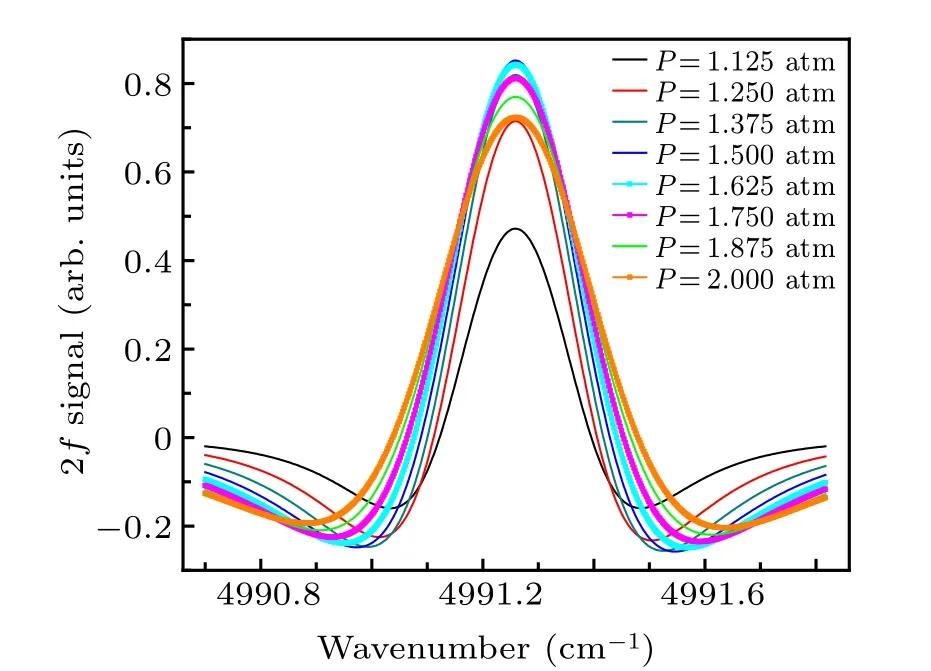
Fig. 2. The simulated 2f signal under 8 groups of concentration and pressure at 0.08 cm?1 modulation amplitude.
Figure 3 depicts the relation between the traditional 2 f amplitude and CO2concentration. The other different modulation amplitudes (including low modulation amplitude 0.04 cm?1and large modulation amplitude 0.16 cm?1) were plotted in the figure. It can be seen from the simulation experiments that there are non-linear and non-monotonic curves between the traditional 2f amplitude and CO2concentration.The traditional 2 f amplitude is proportional to CO2concentration in the 0–20%concentration range(1–1.25 atm pressure),and the pressure broadening effect becomes the main factor affecting the 2 f amplitude in 20%–50% concentration range(1.25–2 atm pressure range). In addition,although increasing modulation amplitude can increase the traditional 2f amplitude and optimize the monotonicity of the curves, it cannot change the non-monotonic characteristics of the curves.
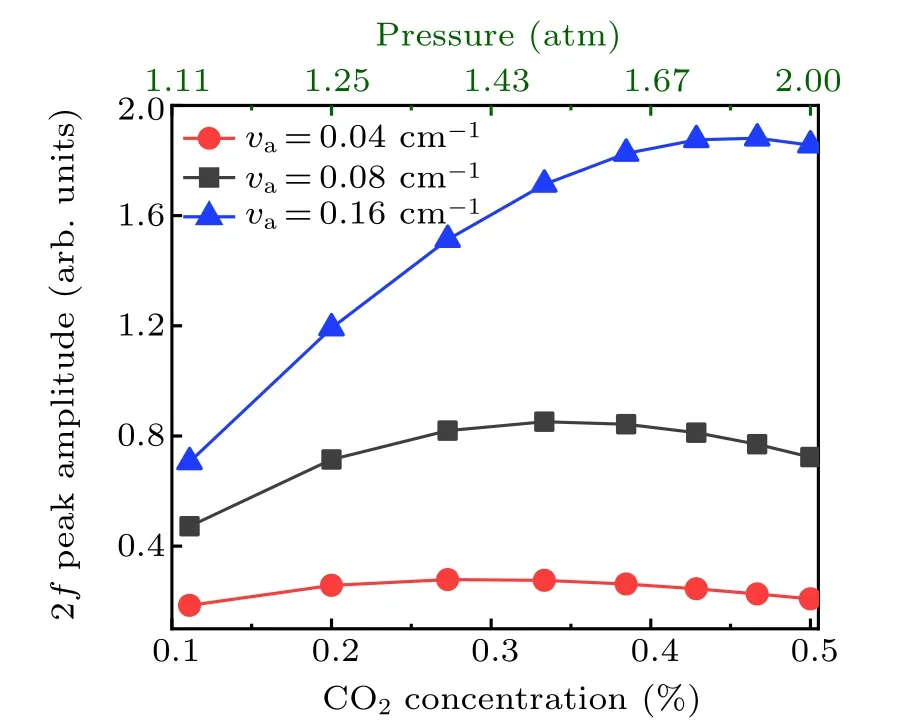
Fig.3. The relation between the traditional 2 f amplitude and CO2 concentration at three different modulation amplitudes.
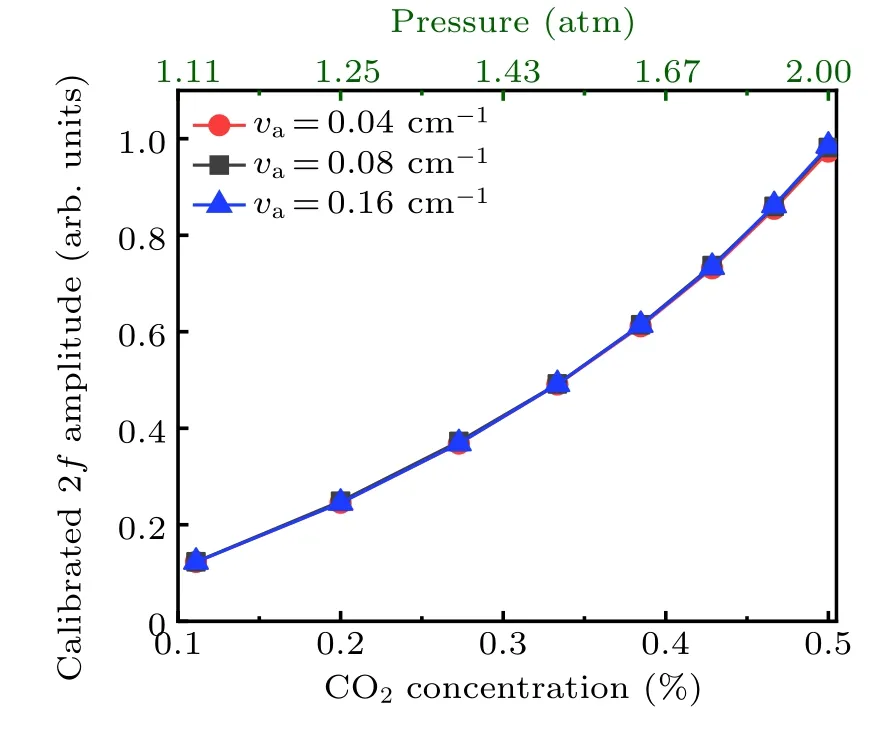
Fig.4. The relation between the calibrated 2 f amplitude and CO2 concentration.
Figure 4 depicts the relation between the calibrated 2f amplitude and CO2concentration, according to Eq. (14).Comparing with the traditional 2f amplitude,there are monotonic curves between the calibrated 2 f amplitude and CO2concentration. At the same time, these curves were not only unaffected by pressure broadening effect,but also independent of modulation amplitudes,so the similar concentration results can be obtained by using the calibrated 2 f amplitude.Through these simulation experiments we can find that the calibrated 2 f amplitude can achieve CO2concentration detection in the sealed environment with increasing pressure, and effectively eliminate the effects of pressure broadening effect. Furthermore,the linear relation between the calibrated 2f amplitude and the CO2particle number is plotted in Fig. 5, according to Eq. (13), and the linear relation can better retrieve microbial growth by using the calibrated 2f amplitude. Thus, this pressure-calibration method provides theoretical support for 2 f-WMS in the sealed microbial growth measurement.

Fig.5. The relation between the calibrated 2f amplitude and the CO2 particle number,the air particle number N0 is 2.48×1019 and the initial pressure P0 is 1 atm.
3. Experiment
A schematic of experimental system was designed for verifying the pressure-calibration method, as exhibited in Fig.6.The 2004 nm distributed feedback(DFB)tunable diode laser was used as a light source. The DFB laser was controlled by a laser driver (Stanford Research System, LDC501) and scanned at 1 Hz by a function generator (RIGOL, DG4162).The laser beam was collimated by an antireflection lens(Thorlabs, F260APC-1550) and introduced into the culture bottle(3 cm path length and 100 mL volume). An InGaAs photodiode(Thorlabs,DET10D/M)was used to detect the laser beam transmitted from the headspaces of the culture bottle. A digital lock-in amplifier(Stanford Research Systems SR830)was used to generate sinusoidal modulation signal at 19 kHz and receive the electrical signal from the photodiode detector. The 2 f signal produced by the lock-in amplifier was acquired by a NI card(National Instruments,NI 6351)and fitted by a computer.
The growth of Escherichia coli coming from American Type Culture Collection (ATCC) was detected in the culture bottle and its initial concentration was 103cfu/mL.The culture temperature was 22°C and kept by a heated incubator. The culture bottle was sealed during the microbial growth process.The growth period was about 70 hours and the measurement interval was 40 min. Finally,the traditional 2f amplitude and calibrated 2 f amplitude were used to detect CO2in the microbial growth.
A flow chart for the pressure-calibration method is shown in Fig. 7. The 2 f absorption signal produced by the lockin amplifier is obtained, through using the 2nd Fourier Lorentzian lineshape function, a fitted 2 f absorption signal can be calculated,where An,Bn,Cn,Dnare furthermore solely functions of ˉvaand ˉvb,for detailed discussion of the Lorentzian lineshape function, refer to Ref. [21]. Furthermore, the fitted Δvcand vacan be deduced when the best-fit parameters between the measured and fitted absorbance signals are obtained. Then according to Eq. (10), 1/ˉχL,2(ˉva) can be calculated. Finally, according to Eq. (11), the pressure-calibration coefficient κ can be calculated.
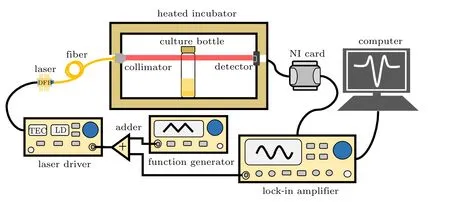
Fig.6. Schematic of experimental system.

Fig.7. Flow chart for pressure-calibration method.
4. Results and discussion
As shown in Fig.8,eight groups of actual fitted 2f signals were took with integer time to illustrate the pressure broadening problem. As noted,from the 0th hour to the 30th hour,the 2 f signals increased with increasing CO2concentration and were basically not affected by the pressure broadening effect.With the rapid growth of Escherichia coli,the amount of CO2increased and caused the pressure in the sealed-environment culture bottle increase rapidly. After the 30th hour, although the amount of CO2increased continuously,the pressure made the linewidth of the 2 f signals broaden and caused the amplitude of the 2f signals to decrease. Especially,for the 2 f signals at the 70th hour(death phase),its amplitude was smaller than the amplitude at 30th hour.Thus,the traditional 2f amplitude was unable to accurately detect CO2in sealed microbial growth environment and cannot correctly retrieve the growth of microorganisms. Because,according to the modified Gompertz model, the CO2concentration should stop increasing at the death phase,rather than decreasing.
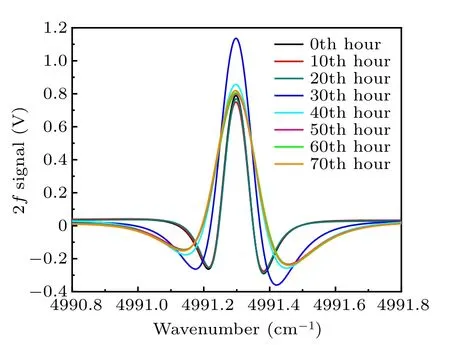
Fig.8. Fitted 2f signals.
Figure 9 depicts the growth of Escherichia coli retrieved by the two different 2 f amplitudes, wherethe blue triangle curve represents the inversion result of traditional 2f amplitude and the red square curve represents the inversion result of the calibrated 2f amplitude. Before the 20th hour,the growth of Escherichia coli was at the lag phase, the growth rate was closed to zero and the amount of CO2was almost unchanged.From the 20th hour, Escherichia coli entered the growth phase, and the growth rate increased from zero to the maximum at the exponential growth phase. However,the microbial growth retrieved by the traditional 2f amplitude reached its maximum at the 24th hour, after that rapidly declined, which cannot accord with the modified Gompertz model. Comparing with the traditional 2 f amplitude, the calibrated 2 f amplitude was not affected by the pressure broadening effect and can accurately retrieve the growth of Escherichia coli. It can be seen that the amount of CO2increased at the exponential phase and the stationary phase and stopped increasing at the death phase. This result accorded with the modified Gompertz model and proved that the pressure-calibration method has an engineering value for the microbial growth.Except for retrieving microbial growth,the method also can be used to calibrate the 2 f amplitude in other sealed environments with increasing pressure.
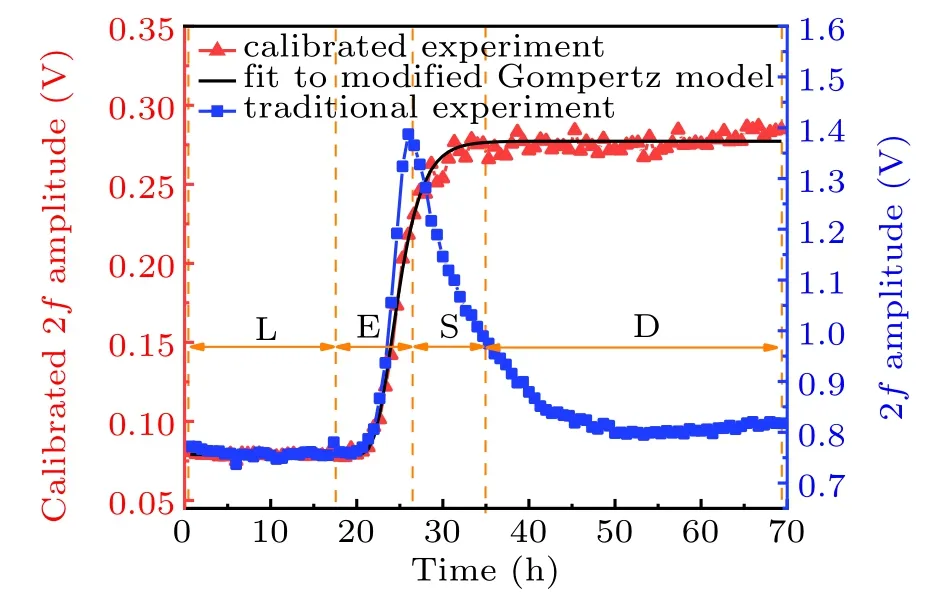
Fig.9. Two 2f amplitudes in the microbial growth,where L:lag phase,E:exponential growth phase,S:stationary phase,D:death phase.
5. Conclusion
A new pressure-calibration method for calibrating the reduction of 2 f amplitude caused by pressure broadening effect in sealed microbial growth environment was introduced. The new method combined with linewidth compensation and modulation depth compensation and made the 2 f amplitude accurately retrieve metabolic CO2without being affected by pressure broadening effect. A simulation experiment was developed,in which the increasing CO2concentration leaded to the increasing pressure. Comparing with the traditional 2 f amplitude,the simulation results of the calibrated 2 f amplitude had a monotonous relation with CO2concentration, particularly,a linear relation was presented when CO2concentration was replaced with the CO2particle number. In order to verify the method,the growth of Escherichia coli was measured,and the culture bottle was in a sealed environment during the microbial growth process.The experimental results showed that comparing with the traditional 2 f amplitude,the calibrated 2 f amplitude can accurately retrieve microbial growth in sealed environment. Except for retrieving microbial growth, the method can also be used to calibrate the 2 f amplitude in other sealed environments with increasing pressure.
- Chinese Physics B的其它文章
- Corrosion behavior of high-level waste container materials Ti and Ti–Pd alloy under long-term gamma irradiation in Beishan groundwater*
- Degradation of β-Ga2O3 Schottky barrier diode under swift heavy ion irradiation*
- Influence of temperature and alloying elements on the threshold displacement energies in concentrated Ni–Fe–Cr alloys*
- Cathodic shift of onset potential on TiO2 nanorod arrays with significantly enhanced visible light photoactivity via nitrogen/cobalt co-implantation*
- Review on ionization and quenching mechanisms of Trichel pulse*
- Thermally induced band hybridization in bilayer-bilayer MoS2/WS2 heterostructure?

